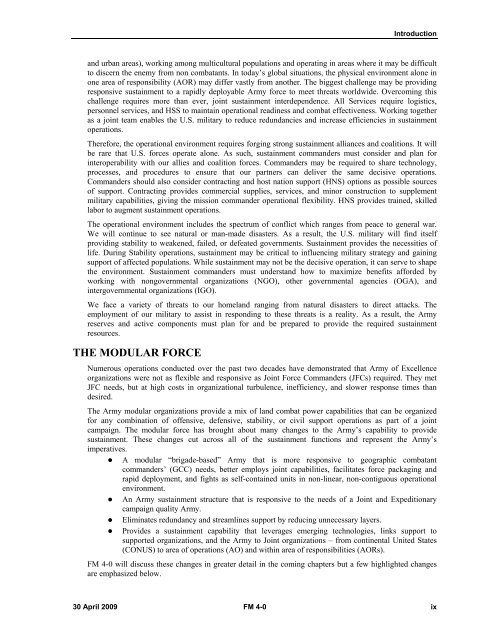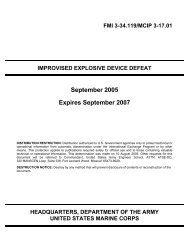FM 4-0, Sustainment - GlobalSecurity.org
FM 4-0, Sustainment - GlobalSecurity.org
FM 4-0, Sustainment - GlobalSecurity.org
- No tags were found...
You also want an ePaper? Increase the reach of your titles
YUMPU automatically turns print PDFs into web optimized ePapers that Google loves.
Introductionand urban areas), working among multicultural populations and operating in areas where it may be difficultto discern the enemy from non combatants. In today’s global situations, the physical environment alone inone area of responsibility (AOR) may differ vastly from another. The biggest challenge may be providingresponsive sustainment to a rapidly deployable Army force to meet threats worldwide. Overcoming thischallenge requires more than ever, joint sustainment interdependence. All Services require logistics,personnel services, and HSS to maintain operational readiness and combat effectiveness. Working togetheras a joint team enables the U.S. military to reduce redundancies and increase efficiencies in sustainmentoperations.Therefore, the operational environment requires f<strong>org</strong>ing strong sustainment alliances and coalitions. It willbe rare that U.S. forces operate alone. As such, sustainment commanders must consider and plan forinteroperability with our allies and coalition forces. Commanders may be required to share technology,processes, and procedures to ensure that our partners can deliver the same decisive operations.Commanders should also consider contracting and host nation support (HNS) options as possible sourcesof support. Contracting provides commercial supplies, services, and minor construction to supplementmilitary capabilities, giving the mission commander operational flexibility. HNS provides trained, skilledlabor to augment sustainment operations.The operational environment includes the spectrum of conflict which ranges from peace to general war.We will continue to see natural or man-made disasters. As a result, the U.S. military will find itselfproviding stability to weakened, failed, or defeated governments. <strong>Sustainment</strong> provides the necessities oflife. During Stability operations, sustainment may be critical to influencing military strategy and gainingsupport of affected populations. While sustainment may not be the decisive operation, it can serve to shapethe environment. <strong>Sustainment</strong> commanders must understand how to maximize benefits afforded byworking with nongovernmental <strong>org</strong>anizations (NGO), other governmental agencies (OGA), andintergovernmental <strong>org</strong>anizations (IGO).We face a variety of threats to our homeland ranging from natural disasters to direct attacks. Theemployment of our military to assist in responding to these threats is a reality. As a result, the Armyreserves and active components must plan for and be prepared to provide the required sustainmentresources.THE MODULAR FORCENumerous operations conducted over the past two decades have demonstrated that Army of Excellence<strong>org</strong>anizations were not as flexible and responsive as Joint Force Commanders (JFCs) required. They metJFC needs, but at high costs in <strong>org</strong>anizational turbulence, inefficiency, and slower response times thandesired.The Army modular <strong>org</strong>anizations provide a mix of land combat power capabilities that can be <strong>org</strong>anizedfor any combination of offensive, defensive, stability, or civil support operations as part of a jointcampaign. The modular force has brought about many changes to the Army’s capability to providesustainment. These changes cut across all of the sustainment functions and represent the Army’simperatives.• A modular “brigade-based” Army that is more responsive to geographic combatantcommanders’ (GCC) needs, better employs joint capabilities, facilitates force packaging andrapid deployment, and fights as self-contained units in non-linear, non-contiguous operationalenvironment.• An Army sustainment structure that is responsive to the needs of a Joint and Expeditionarycampaign quality Army.• Eliminates redundancy and streamlines support by reducing unnecessary layers.• Provides a sustainment capability that leverages emerging technologies, links support tosupported <strong>org</strong>anizations, and the Army to Joint <strong>org</strong>anizations – from continental United States(CONUS) to area of operations (AO) and within area of responsibilities (AORs).<strong>FM</strong> 4-0 will discuss these changes in greater detail in the coming chapters but a few highlighted changesare emphasized below.30 April 2009 <strong>FM</strong> 4-0 ix

















